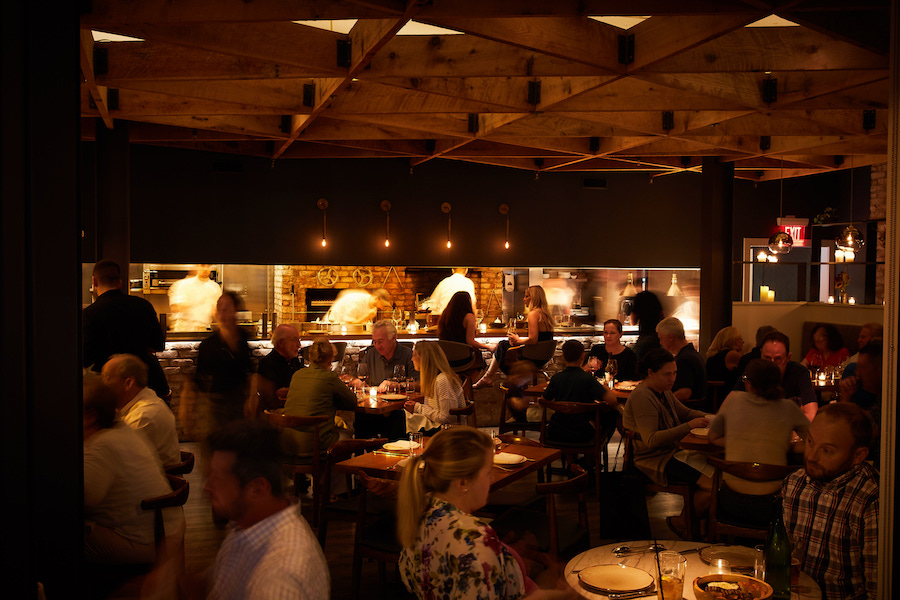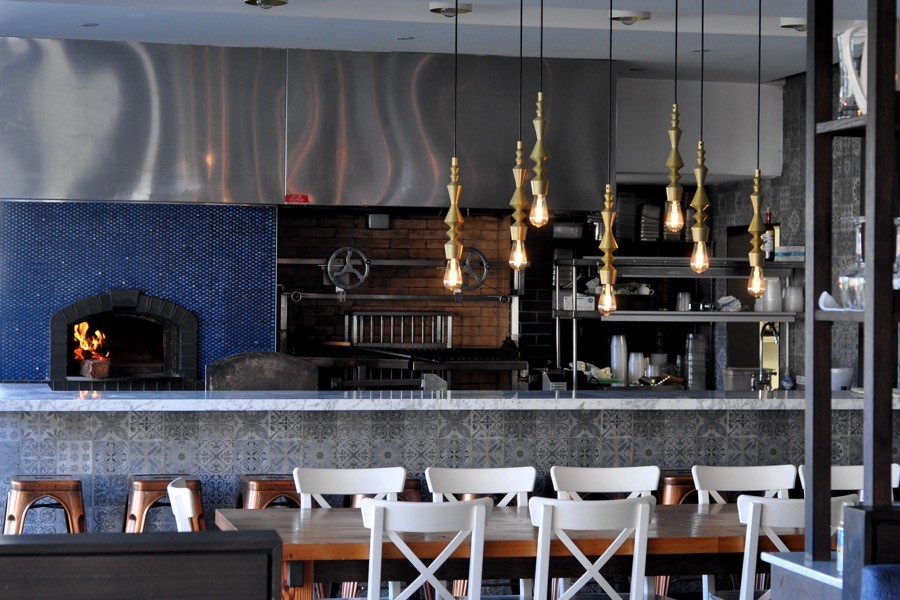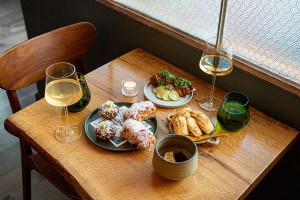The Latest Trend in Philly Restaurants? Revamping Your Concept
Some chef-owners in the Philly area are reimagining their restaurants to account for staffing difficulties, improve work-life balance, and flex their creative muscles.

A busy dining room at Collingswood’s Hearthside, where owner Dominic Piperno has ceased a la carte service in favor of a prix-fixe menu that changes every two weeks./ Photograph courtesy of Hearthside
Six months ago, a meal at Laurel was a hushed affair. Diners came to chef Nick Elmi’s East Passyunk restaurant for special occasions, eating seasonal dishes with academic intensity over a span of two and a half hours. It was textbook fine dining, or as close to textbook fine dining as we have in Philadelphia.
On a recent Wednesday night, though, the dining room at Laurel was full of energy. Guests deliberated over the menu and drank coconut fat-washed Negronis, servers moved through a revamped space carrying plates of Cape May oysters, celery salad crowned with ricotta salata, and fragrant and comforting Parisian gnocchi.
This scene will be the norm going forward. Elmi and his new business partners — general manager Jane Fryer, who has been working at the restaurant for six years, and chef de cuisine Kevin McWilliams — have reinvented Laurel as an a la carte experience.
“I just got tired of tasting menus,” Elmi explains from the renovated dining room at Laurel, now full of light-wood tables, white brick, and back-lit mirrors above banquette seating. “I opened Laurel because I had been at Le Bec-Fin and I was like, ‘What if I did fine dining like that, but it was fun?’ and then, over the course of 10 years, it became this really serious thing. I never wanted that.”

Laurel’s chef de cuisine Kevin McWilliams. / Photograph courtesy of Younger Brother Pictures
Over in Collingswood, Hearthside’s Dominic Piperno came up with the opposite solution. On March 1st of this year, the owner and his team nixed their a la carte option in favor of prix-fixe. For $125 per person, guests sit down for a family-style meal that rotates themes every two weeks. They’re offering a “super spring” menu, full of morels and fresh peas, plotting a Tuscan steakhouse theme for late May, and a Jersey Shore theme after that.
“I realized that, at any moment, if a line cook said they were leaving, everything was going to fall apart,” Piperno tells me. “We had just been keeping our heads above water since 2020, and we needed to step back and figure out how to love the restaurant again.” The homepage of Hearthside’s website informs guests of the BYOB’s tweaked concept, citing rising food and labor costs, and labor shortages as an impetus for change. Without enough staff in the restaurant, everyone’s hours had stretched longer and longer, leaving the team feeling exhausted and creatively tapped.
“I feel like a chef again,” Piperno says. “For a long time after COVID, we were constantly running. Now, the staff can come in a little later and leave a little earlier, and everyone has the energy and time to be creative and involved in the menu design.”
For the kitchen, Hearthside’s new model is more efficient and predictable than a la carte service. When every diner in the restaurant is eating the same family-style spread of dishes, there’s less waste and therefore increased margins. The streamlined menu also means Hearthside needs fewer people to execute dishes, which alleviates labor costs and pressure to hire new staff.

Fiore Fine Foods’s open kitchen. The team closed their Queen Village restaurant at the beginning of April and will reopen in a smaller space in Fishtown later this summer. / Photograph by Alexandra Jones
For Justine MacNeil and Ed Crochet at Fiore Fine Foods, the pandemic’s challenging hiring landscape was a key factor in their decision to adapt the restaurant’s model. MacNeil and Crochet closed their Queen Village Italian spot at the beginning of April. Later this summer, they will re-open Fiore in Fishtown with less than half the space, no liquor license, no dinner service, and a focus on breakfast and lunch.
“In 2021, staffing started to feel like a fool’s errand,” Crochet said. “We just stopped posting the listings because we wouldn’t hear anything.”
The space at 757 Front Street where Fiore operated in Queen Village measures 5,000 square feet. This is, by most restaurant standards, enormous. (By contrast, Hearthside’s space is 3,000 square feet, and Laurel’s is less than 1,000 square feet.) The restaurant’s size required two people to manage operations at once, a responsibility that MacNeil and Crochet shared. Then, in early 2021, they had a baby.
“Before he was born, we had this idea that we would put him on a night schedule and he would just run around the restaurant,” MacNeil says. “But as soon as he started crawling, we realized that wasn’t going to work. It quickly became that if I was at the restaurant, Ed was at home and if Ed was at the restaurant, I was at home, because they don’t make a lot of daycare for night schedules.”
The daytime focus of the new Fiore location is MacNeil and Crochet’s solution: Its smaller size will streamline operations, easing the pressure for both of them to be in the restaurant at any given moment.
“When we moved to Philadelphia, our wild dream was to start small, get bigger,” MacNeil says. “But when we shut down because of COVID, our priorities shifted. If we had wanted to keep going, we would have needed to probably bring in a partner or something, but that’s not what we wanted to do.”

Beef tartare on Laurel’s new a la carte menu. / Photograph by In Between Rivers
Back at Laurel, Elmi decided that delegating was exactly what he wanted to do. He brought on Fryer and McWilliams as partners to expand the net of people taking responsibility for the barrage of problems that come up in a restaurant: from sick staff to late deliveries, and everything in between. Sharing that responsibility has been a weight lifted for Elmi — he feels like he can leave the restaurant in Fryer’s and McWilliams’s hands.
“I’ve never worked with a team before who says to me ‘Okay, here’s the problem and here’s how we fixed it,’” Elmi says. “It was always ‘Here’s the problem, what should we do?’ That’s what has allowed all of us to commit to this restaurant, that is in some ways more ambitious than what Laurel used to be.” Laurel is more ambitious, he explains, because the menu will change more often. The a la carte set-up includes more dishes than the tasting menu previously offered, which in turn requires more preparation for the kitchen. While it may seem counterintuitive, making casual, a la carte service feel effortless requires even more exacting standards for both front and back of house.
Part way through my meal at Laurel, Elmi stopped by the table to say goodbye. He was headed home before 9:30 p.m., a surprising move for someone who had essentially opened a new restaurant within the last two weeks. But by removing himself from the center of the restaurant’s operations, Elmi has made space for a more creative version of the Laurel he’d originally built.
COVID sidelined some amount of creativity in Philly kitchens. But, by adapting their business models, it’s possible that restaurants like Laurel will emerge as more fun, more delicious, and more exciting than they’ve been before.


